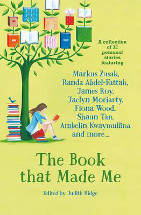The book that made me ed. by Judith Ridge

Walker Books, 2016. ISBN 9781922244888
(Age: Mature upper primary - Secondary, Adult) Most avid readers
will understand how special it is to share a book with someone. This
may be through encouraging others to read a title, or from
discussion in study, book clubs or impromptu conversation.
This publication compiles submissions by authors who explain how
they were moved, comforted, inspired and influenced by books and it
differs from others in that the authors don't have pretensions and
make no effort to impress with a taste for high brow literature.
Originally I thought it might be a clever way to engage reluctant
readers, however I soon realised that this is a book for people who
love reading, those who want to cheer when someone else voices
exactly what they felt about scenes from their favourite childhood
tale or who want to feel cross that someone just didn't 'get' the
book which meant the most to them in their teens.
It meant a lot to me that different authors voiced similar thoughts
about titles. For example, Fiona Wood first encountered notions of
feminism from the strong, decent and very human main character in Anne
of Green Gables. Rachel Craw also recalls Anne as a powerful
female character yet notes that Trixie Belden was her first.
Benjamin Law fondly remembers the works of Roald Dahl, as does
Bernard Beckett who also experienced the joy of sharing this author
with his own boys via an audio book on a long car journey.
In many of the entries is a sense of yearning for happy, simple
moments from childhood, framed within the familiar setting of
favourite books. For some, it is clear that books helped the
endurance of difficult times, such as family disintegration and
isolation in remote locations.
I was transported by the authors who recalled the excitement of the
weekly visit to a public library, to select three books which would
be devoured, some several times, before the next visit. It was also
interesting to read the opinions of individuals from an array of
cultural backgrounds, to appreciate the value of different forms,
such as spoken narrative, comics and graphic novels. Clearly some
stories had almost universal appeal whilst others may have reflected
blinkered attitudes from their time.
Some secondary and a few advanced primary students will enjoy
reading the views and experiences of these authors, however many
contributors will be unfamiliar. Similarly, with some exceptions, a
lot of the titles discussed are so dated that they are unlikely to
be known. However, I'd be delighted if this book prompts readers to
search out these treasured favourites which they might otherwise not
have come across.
Rob Welsh